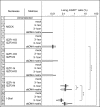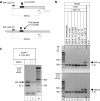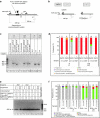Zinc-finger nuclease-induced gene repair with oligodeoxynucleotides: wanted and unwanted target locus modifications
- PMID: 20068556
- PMCID: PMC2862519
- DOI: 10.1038/mt.2009.304
Zinc-finger nuclease-induced gene repair with oligodeoxynucleotides: wanted and unwanted target locus modifications
Abstract
Correcting a mutated gene directly at its endogenous locus represents an alternative to gene therapy protocols based on viral vectors with their risk of insertional mutagenesis. When solely a single-stranded oligodeoxynucleotide (ssODN) is used as a repair matrix, the efficiency of the targeted gene correction is low. However, as shown with the homing endonuclease I-SceI, ssODN-mediated gene correction can be enhanced by concomitantly inducing a DNA double-strand break (DSB) close to the mutation. Because I-SceI is hardly adjustable to cut at any desired position in the human genome, here, customizable zinc-finger nucleases (ZFNs) were used to stimulate ssODN-mediated repair of a mutated single-copy reporter locus stably integrated into human embryonic kidney-293 cells. The ZFNs induced faithful gene repair at a frequency of 0.16%. Six times more often, ZFN-induced DSBs were found to be modified by unfaithful addition of ssODN between the termini and about 60 times more often by nonhomologous end joining-related deletions and insertions. Additionally, ZFN off-target activity based on binding mismatch sites at the locus of interest was detected in in vitro cleavage assays and also in chromosomal DNA isolated from treated cells. Therefore, the specificity of ZFN-induced ssODN-mediated gene repair needs to be improved, especially regarding clinical applications.
Figures






Similar articles
-
Cellular responses to targeted genomic sequence modification using single-stranded oligonucleotides and zinc-finger nucleases.DNA Repair (Amst). 2009 Mar 1;8(3):298-308. doi: 10.1016/j.dnarep.2008.11.011. Epub 2008 Dec 30. DNA Repair (Amst). 2009. PMID: 19071233
-
Genome editing with CompoZr custom zinc finger nucleases (ZFNs).J Vis Exp. 2012 Jun 14;(64):e3304. doi: 10.3791/3304. J Vis Exp. 2012. PMID: 22732945 Free PMC article.
-
Targeted chromosomal gene modification in human cells by single-stranded oligodeoxynucleotides in the presence of a DNA double-strand break.Mol Ther. 2006 Dec;14(6):798-808. doi: 10.1016/j.ymthe.2006.06.008. Epub 2006 Aug 14. Mol Ther. 2006. PMID: 16904944
-
Zinc Finger Nucleases: A new era for transgenic animals.Ann Neurosci. 2011 Jan;18(1):25-8. doi: 10.5214/ans.0972.7531.1118109. Ann Neurosci. 2011. PMID: 25205916 Free PMC article. Review.
-
Custom-designed zinc finger nucleases: what is next?Cell Mol Life Sci. 2007 Nov;64(22):2933-44. doi: 10.1007/s00018-007-7206-8. Cell Mol Life Sci. 2007. PMID: 17763826 Free PMC article. Review.
Cited by
-
Repeatable construction method for engineered zinc finger nuclease based on overlap extension PCR and TA-cloning.PLoS One. 2013;8(3):e59801. doi: 10.1371/journal.pone.0059801. Epub 2013 Mar 25. PLoS One. 2013. PMID: 23536890 Free PMC article.
-
Extensive trimming of short single-stranded DNA oligonucleotides during replication-coupled gene editing in mammalian cells.PLoS Genet. 2020 Oct 29;16(10):e1009041. doi: 10.1371/journal.pgen.1009041. eCollection 2020 Oct. PLoS Genet. 2020. PMID: 33119594 Free PMC article.
-
Targeted gene therapies: tools, applications, optimization.Crit Rev Biochem Mol Biol. 2012 May-Jun;47(3):264-81. doi: 10.3109/10409238.2012.658112. Crit Rev Biochem Mol Biol. 2012. PMID: 22530743 Free PMC article. Review.
-
Virus-mediated Genetic Surgery: Homologous Recombination With a Little "Helper" From My Friends.Mol Ther Nucleic Acids. 2012 Jan 24;1(1):e2. doi: 10.1038/mtna.2011.7. Mol Ther Nucleic Acids. 2012. PMID: 23344619 Free PMC article. No abstract available.
-
In vivo genome editing using a high-efficiency TALEN system.Nature. 2012 Nov 1;491(7422):114-8. doi: 10.1038/nature11537. Epub 2012 Sep 23. Nature. 2012. PMID: 23000899 Free PMC article.
References
-
- Cavazzana-Calvo M, Hacein-Bey S, de Saint Basile G, Gross F, Yvon E, Nusbaum P, et al. Gene therapy of human severe combined immunodeficiency (SCID)-X1 disease. Science. 2000;288:669–672. - PubMed
-
- Gaspar HB, Parsley KL, Howe S, King D, Gilmour KC, Sinclair J, et al. Gene therapy of X-linked severe combined immunodeficiency by use of a pseudotyped gammaretroviral vector. Lancet. 2004;364:2181–2187. - PubMed
-
- Hacein-Bey-Abina S, Von Kalle C, Schmidt M, McCormack MP, Wulffraat N, Leboulch P, et al. LMO2-associated clonal T cell proliferation in two patients after gene therapy for SCID-X1. Science. 2003;302:415–419. - PubMed
Publication types
MeSH terms
Substances
LinkOut - more resources
Full Text Sources
Other Literature Sources

